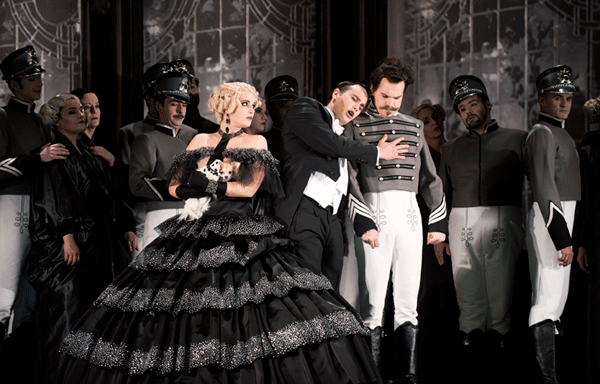Kurt Gänzl
The Encyclopedia of the Musical Theatre
12 October, 2021
The most successful stage musical work of Reynaldo Hahn, Ciboulette was written to a text by two of the most admired French playwrights of its time, Robert de Flers and – in succession to his longtime partner de Caillavet – Francis de Croisset. It was no longer a burlesque text, like the ones de Flers and de Caillavet had written for Terrasse with such success, but a piece of prettily pastel-coloured romance, with some gentle humour and a certain charm, which Hahn illustrated with a score written in a similar vein. The show premiere at the Théâtre des Variétés in Paris on 7 April, 1923.
A scene from the original 1923 production of “Ciboulette” at the Théâtre des Variétés
Rodolphe Duparquet (Jean Périer), comptroller of the Les Halles markets, watches sadly as the actress Zénobie (Jeanne Perriat) plays fast and loose with the affections of the naïve young Vicomte Antonin de Mourmelon (Henri Defreyn) and, finally, he reveals her duplicity to the young man. Antonin has lost a mistress but found a friend, and soon he finds another in the person of Ciboulette (Edmée Favart), a little farm-girl who comes into town to sell her goods at Les Halles.

The Théâtre des Variétés in Paris, around 1900. (Photo: Georges Imbert / Wiki Commons)
Ciboulette has been told that she will find her destined husband under a cabbage, win him away from a woman who will go white-haired in an instant, and that she will receive notice of his death in a tambourine.
When the sleepy Antonin emerges from the back of her vegetable cart, the first condition is fulfilled, when Ciboulette tips a bag of flour over Zénobie’s head, the second comes true, and, in the third act, when Ciboulette has gone on to become a famous prima donna, like all the best operettic vegetable-sellers, she gets the letter – which the suicidal Antonin had entrusted to a butler for later delivery – after their reunion has been happily effected.

Reynaldo Hahn sitting at the piano, painted by Lucie Lambert in 1907.
Hahn equipped his Ciboulette with several sweet and sprightly soprano numbers (‘Dans un’ charrett’’, ‘Moi, j’ m’appelle Ciboulette’, ‘C’est sa banlieue’, the Chanson de Route) as well as a prima donna number for the last act (‘Amour qui meurs, amour qui passes!’), and she joined prettily in duet ‘Comme frère et soeur’ with her new-found friend, but the highlight of the show was Duparquet’s number ‘C’est tout ce qui me reste d’elle’.
When the tearful Ciboulette comes to dampen his shoulder after giving the insufficiently backboned Antonin his marching orders, Duparquet tells her his own sad story of love. His christian name gives it away – he is the Rodolphe of Murger and of Puccini, and his love story is the tale of his little, lost Mimi. All that he has left is a tiny handkerchief that was hers, which he keeps in his coat pocket, next his heart.
Daringly ingenuous and sentimental, Duparquet’s scene and song triumphed by the quality of their writing, and they added an extra dimension to an otherwise conventional, if skilfully made, opérette with which Hahn and his librettists had the curious idea to challenge the fashionable musical comedies of the 1920s.

Scene from a modern-day vegetable market. (Photo: @nicotitto / Unsplash)
Ciboulette was a decided success in Paris, and it was reprised on several occasions: at the Théâtre Marigny in 1926 (2 October) with Mlle Favart, Defreyn and with André Baugé as Duparquet, again at the Gaîté-Lyrique in 1931 with Nini Roussel starred, and in 1935 (20 January) with Renée Camia, André Noel and Aquistapace.
In the same year, a film version was produced by Claude Autant-Lara with Simone Berriau, Dranem and Robert Burnier featured. However, although the piece proved both popular and well-regarded in France, it attracted no buyers elsewhere.

Poster for the “Ciboulette” film version, starring Simone Berriau.
Hassard Short announced a production for Broadway which never eventuated, and the other main centres showed no interest. Yet the piece continued to hold its place in the French repertoire, returning to Paris in 1953 (13 March) at no less a venue than the Opéra-Comique with Géori Boué, Raymond Amade and Roger Bourdin featured, and again in 1975 (25 October) with Nicole Broissin, André Battedou and Henri Gui.
It has also continued to be played regularly in provincial houses without showing any signs of being considered old or, by modern standards, saccharine.

Scene from the 2013 Opera Comique production of “Ciboulette”. (Photo: E. Carrechio/Opera Comique)
What seems to have been an American première (ad James Stuart) was mounted by the Ohio Light Opera in 1990 with Michael Jones as Duparquet, Dawn Hess as Ciboulette and William Joyner as Antonin.
